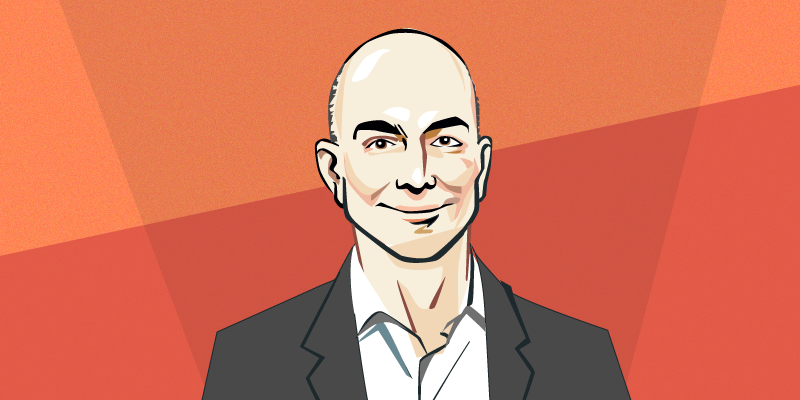The annual letter to shareholders from Jeff Bezos offers an Amazon-worth of learning
Jeff Bezos, the Founder and CEO of Amazon, has released his annual letter to the company’s shareholders and it is a mine of knowledge. Jeff is the richest man in the world and the force behind one of the biggest companies of our times. This is the 20th anniversary of his annual letter to shareholders, where he points out that the company values continue to remain the same.

The letter is a great opportunity for business leaders to draw from what separates the good from the great. The letter opens up some of the values and key points that make Amazon what it is today – a success story.
Jeff Bezos started with customer validation and shared how Amazon has been ranked on the top by its customers but is also the best place to work. Given that Amazon has a huge team of 560,000 people, it’s no mean feat to be one of the top companies to work for, and Jeff points out the same in his letter.
His letter is a great source for entrepreneurs to learn and understand what it takes to build, grow, scale, and most importantly, sustain a business as huge and mammoth as Amazon.
Customer is everything
The customer is the key. Time and again, experts and leaders have emphasised that businesses that keep the focus on the customer are bound to succeed.
In his letter, Jeff talks about customer experience and how to deliver on it, “One thing I love about customers is that they are divinely discontent. Their expectations are never static – they go up. It’s human nature. We didn’t ascend from our hunter-gatherer days by being satisfied. People have a voracious appetite for a better way, and yesterday’s ‘wow’ quickly becomes today’s ‘ordinary’. I see that cycle of improvement happening at a faster rate than ever before. It may be because customers have such easy access to more information than ever before – in only a few seconds and with a couple taps on their phones, customers can read reviews, compare prices from multiple retailers, see whether something’s in stock, find out how fast it will ship or be available for pick-up, and more. These examples are from retail, but I sense that the same customer empowerment phenomenon is happening broadly across everything we do at Amazon and most other industries as well. You cannot rest on your laurels in this world. Customers won’t have it.”
So how does Amazon stay on top and meet ever-rising customer expectations? By doing multiple things together, including learning from failure, using that learning every day, and also trying to meet the high expectations of the customers.
Jeff speaks about how high standards are not intrinsic but teachable. It is something one can teach people. “In fact, people are pretty good at learning high standards simply through exposure. High standards are contagious. Bring a new person to a high standards team, and they’ll quickly adapt. The opposite is also true. If low standards prevail, those too will quickly spread.”
How to get to be the best?
Jeff points out that high standards are hard to achieve and it is not a general thing but is domain specific. You have to achieve it in every domain and be open to the fact that sometimes you may not even know what is the ultimate or the highest standard in a domain, but as long as you are humble and ready to learn, you will be fine.
“I believe high standards are domain-specific, and that you have to learn high standards separately in every arena of interest. When I started Amazon, I had high standards on inventing, on customer care, and (thankfully) on hiring. But I didn’t have high standards on operational process: how to keep fixed problems fixed, how to eliminate defects at the root, how to inspect processes, and much more. I had to learn and develop high standards on all of that (my colleagues were my tutors).”
According to Jeff, the way to achieve this high standard is two-pronged. You first need to recognise what “looks good in a domain”, and second, you need to have realistic expectations. About the latter, he writes, “Unrealistic beliefs on scope – often hidden and undiscussed – kill high standards. To achieve high standards yourself or as part of a team, you need to form and proactively communicate realistic beliefs about how hard something is going to be.”
Why high standards matter?
Once you have had the best, would you go settle for the second-best? That is the question Jeff throws to us. He tells us why high standards matter and why we need to aspire to them.
“Building a culture of high standards is well worth the effort, and there are many benefits. Naturally and most obviously, you’re going to build better products and services for customers – this would be reason enough! Perhaps a little less obvious: people are drawn to high standards – they help with recruiting and retention. More subtle: a culture of high standards is protective of all the ‘invisible’ but crucial work that goes on in every company. I’m talking about the work that no one sees. The work that gets done when no one is watching. In a high standards culture, doing that work well is its own reward – it’s part of what it means to be a professional.”
And so he insists in his letter that it is pertinent to demand high standards all the time. It is part of the Amazon leadership principles too. If you are thinking how it applies to everything, then Jeff has an answer for that as well:
“So, the four elements of high standards as we see it: they are teachable, they are domain-specific, you must recognize them, and you must explicitly coach realistic scope. For us, these work at all levels of detail. Everything from writing memos to whole new, clean-sheet business initiatives. We hope they help you too.”








![[Funding alert] Alternative credit platform BlackSoil raises Rs 32Cr via NCDs](https://images.yourstory.com/cs/2/3fb20ae02dc911e9af58c17e6cc3d915/Ankurimage-1600856808384.jpeg)


